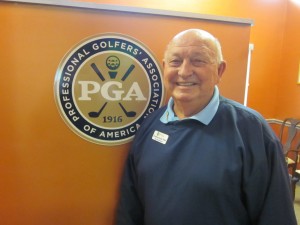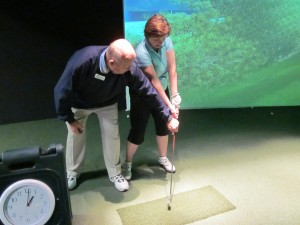This past winter when my wife and I spent some time in Florida we drove across the lower middle of the state, starting west from Naples to Port St. Lucie. It was a pleasant drive and we saw parts of the state we’ve never seen before. Along the way, we saw this sign: “Talk less, say more.” Darn if the message didn’t sum up later the captivating teaching philosophy of Charlie Sorrell, the former National PGA Teacher of the Year and two-time headliner at the West Michigan Golf Show. Now this doesn’t mean Charlie is a quiet sort. Quite the contrary. Rather he’s a jovial, talkative personality but when he’s giving a lesson his words are carefully chosen.
A long time industry friend whom I first met when he won his national award in 1990, Sorrell, 71, is staying young by teaching at the PGA Center for Golf Learning and Performance in Port St. Lucie, FL. “My job is take on the overflow,” says Sorrell. “I’m the on-call doctor.” Sorrell and his beloved wife Joyce retired to Port St. Lucie in 2007 after selling their home and property which housed his Golf Meadows teaching academy in Stockbridge, GA. He’s compiled a laudable teaching career that emphasizes a non-jargon, simple and fun approach to giving golf lessons. He’s also known for his clever rhymes to stress certain swing fundamentals, such as: “Wrists that are tight/destroy ball flight” and “When you’re balanced throughout the swing/A repeatable motion is a sure thing.”
A long time ago, Deb and I visited the always affable and self-effacing Charlie at his teaching academy in Georgia and he provided Deb with the most effective lesson she’s ever had—then or now. Basically, he encouraged her to generate more clubhead speed while remaining on plane by this simple adage: “Hinge and sling.” He got Deb to correctly hinge her wrists, creating a powerful and correct angle, and then for her to swing through the shot. The results were immediate and remarkable. As Charlie more fully explained, “The hands are made to hold, the wrists are made to hinge, the arms are made to fold and the arms are made to swing.”
Sorrell’s golf career was influenced by his first boss in the business, Virgil Morey, head professional at Riverside CC in Lanette, Alabama. “He gave me two very important lessons about teaching golf. Number one: kill them with kindness; and number two: learn how to cure a slice or a hook quickly.” In over forty years teaching the game he loves, Sorrell has added a third bedrock tenet. “I also stress MYFI—which stands for Making You Feel Important.”
Over the winter, Sorrell was part of a panel presentation that talked about “blending the old styles of teaching of modern technology.” He said today’s teachers have excellent tools, particularly with video, to identify and correct swing maladies. “But the human element of teaching can’t be underestimated,” says Sorrell, “because everything still must be communicated properly.” When asked about Tour Tempo and its recent research findings on tempo for Tour player swings, Sorrell brought up the story of how in winning the 1937 Masters Byron Nelson reminded himself to compare his swing tempo to dancing a waltz. “Most of what we know about the game and the swing is not new; but we’re seeing it in a new light with the help of technology.”
Sorrell, a PGA Master Golf Professional, is a joy to be around because he loves what he does, helping to put a “smile back on a golfers’ faces as they play the game of a lifetime.” And it’s the everyday golfer getting better that remains the focus of his attention and astute eye. Sorrell said: “I always remember something Bob Toski once told me, ‘Anyone can teach a Tour player. That’s easy compared to working with beginners or struggling average golfers.’ ”
Deb Moore was one such struggling golfer. But after another lesson with Charlie Sorrell, she was hinging, swinging and smiling.
For more information about the PGA Center for Golf Learning and Performance visit www.pgavillage.com


